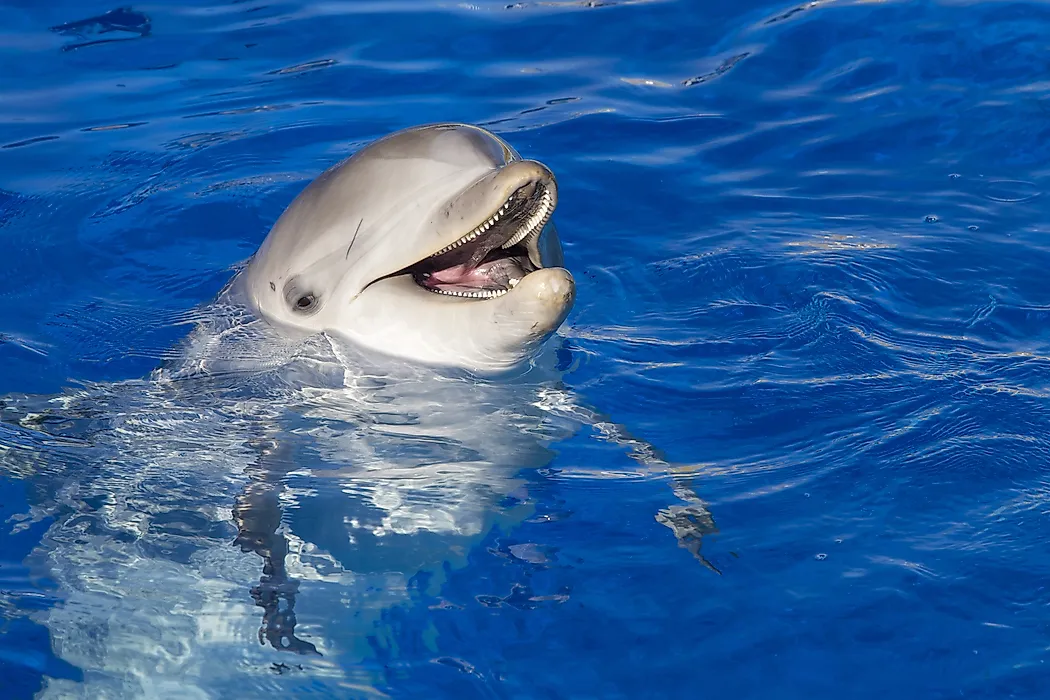Bottlenose Dolphin Facts: Animals of North America

5. Physical Description
Bottlenose dolphins are a species of marine mammals that belong, alongside whales and porpoises, to the Cetacean Order, whose closest terrestrial relatives on land include Hippopotamuses. Adults range from roughly 6.5 to 13 feet in length and from 330 to nearly 1500 pounds in weight. The top halves of their bodies are grey, while the bottoms are closer to white, a color combination which effectively camouflages them from both above and below while swimming. As their names suggest, bottlenose dolphins have narrow, bottle-shaped snouts, which help to streamline their sleek, powerful bodies, and subsequently place them among the ocean’s most efficient swimmers. These snouts are filled with 18-28 conical teeth, which they use in hunting and feeding.
4. Diet
The Bottlenose dolphins' diets' are composed primarily of fish species, such as mullet, tuna, and mackerel. They’ve also been known to eat species of bottom feeders, as well as a variety of crustaceans and squid. Though dolphins occasionally hunt alone, they more commonly hunt in groups, relying on teamwork to herd schools of fish towards shores and maximize their kills. They make these kills with their sharp teeth and, at times, through a practice aptly nicknamed “fish whacking,” wherein they will stun their prey with their snouts, sometimes even knocking them out of the water. Dolphins have also been known to follow fishing boats, at times even stealing fish from their nets.
3. Habitat and Range
The bottlenose dolphin is an extremely adaptive animal, which allows its range to be quite broad. Present throughout the majority of the Pacific, Atlantic, and Indian Oceans and their adjoining seas, these dolphins can be found both close along shorelines and far out at sea. And while they can thrive in a variety of environments, their size does tend to vary depending on their habitat, which is more affected by water temperature. Dolphins in warmer, shallower waters are generally smaller, while those in cooler, pelagic regions are typically larger. At the moment, bottlenose dolphins are not endangered, though they are, like many marine species, affected by habitat loss, pollution, and fishing. Smaller dolphins are also preyed on by a variety of shark species, such as bull, tiger, and great white sharks.
2. Behavior
Bottlenose dolphins are extremely social animals, and as such can generally be found living in groups called 'pods'. These pods can range from 2 or 3 dolphins to, in rarer instances, in excess of 1,000 members. Within these groups, Bottlenose dolphins communicate with 'echolocation', a form of sonar wherein the dolphin detects objects by producing a range of squeaks and clicks, and listening for the resulting echoes. Dolphins are known for their playful nature, and can often be seen frolicking and leaping out of the water. That said, males are known to become very aggressive with each other during mating season, and the species has also been known to attack marauding sharks.
1. Reproduction
As mammals, bottlenose dolphins bear live young, rather than laying eggs like fish, reptiles, and birds. During the species’ breeding season, the males will compete for female mates, often fighting one another, and at times even working in pairs to isolate and protect a single female. Once mating has successfully occurred, a female will gestate for an average of 12 months. The resulting young, generally being just a single calf, will then be birthed in warmer, shallow waters. They will then suckle for anywhere from 18 months to as long as 8 years, and will often maintain a close relationship with their mothers well after weaning.











